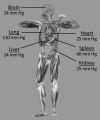Hypoxia and senescence: the impact of oxygenation on tumor suppression
- PMID: 21385881
- PMCID: PMC3096743
- DOI: 10.1158/1541-7786.MCR-11-0065
Hypoxia and senescence: the impact of oxygenation on tumor suppression
Abstract
Cellular senescence has emerged as a biological response to two major pathophysiological states of our being: cancer and aging. In the course of the transformation of a normal cell to a cancerous cell, senescence is frequently induced to suppress tumor development. In aged individuals, senescence is found in cells that have exhausted their replication potential. The similarity in these responses suggests that understanding how senescence is mediated can provide insight into both cancer and aging. One environmental factor that is implicated in both of these states is tissue hypoxia, which increases with aging and can inhibit senescence. Hypoxia is particularly important in normal physiology to maintain the stem cell niche; but at the same time, hypoxic inhibition of an essential tumor suppressor response can theoretically contribute to cancer initiation.
Figures



Similar articles
-
Saturated fatty acid metabolism is key link between cell division, cancer, and senescence in cellular and whole organism aging.Age (Dordr). 2010 Jun;32(2):231-7. doi: 10.1007/s11357-009-9128-x. Epub 2010 Jan 14. Age (Dordr). 2010. PMID: 20431990 Free PMC article. Review.
-
Role of Sirtuin1-p53 regulatory axis in aging, cancer and cellular reprogramming.Ageing Res Rev. 2018 May;43:64-80. doi: 10.1016/j.arr.2018.02.004. Epub 2018 Feb 21. Ageing Res Rev. 2018. PMID: 29476819 Review.
-
p63: a new link between senescence and aging.Cell Cycle. 2006 Feb;5(3):260-5. doi: 10.4161/cc.5.3.2415. Epub 2006 Feb 1. Cell Cycle. 2006. PMID: 16434880 Review.
-
Oxidative stress activates a specific p53 transcriptional response that regulates cellular senescence and aging.Aging Cell. 2013 Jun;12(3):435-45. doi: 10.1111/acel.12060. Epub 2013 Mar 27. Aging Cell. 2013. PMID: 23448364 Free PMC article.
-
Senescence and aging: the critical roles of p53.Oncogene. 2013 Oct 24;32(43):5129-43. doi: 10.1038/onc.2012.640. Epub 2013 Feb 18. Oncogene. 2013. PMID: 23416979 Review.
Cited by
-
Senescent Tumor Cells Build a Cytokine Shield in Colorectal Cancer.Adv Sci (Weinh). 2021 Jan 4;8(4):2002497. doi: 10.1002/advs.202002497. eCollection 2021 Feb. Adv Sci (Weinh). 2021. PMID: 33643790 Free PMC article.
-
Hypoxic reactivation of Kaposi's sarcoma associated herpesvirus.Cell Insight. 2024 Sep 7;3(6):100200. doi: 10.1016/j.cellin.2024.100200. eCollection 2024 Dec. Cell Insight. 2024. PMID: 39391006 Free PMC article. Review.
-
Oxygen levels and the regulation of cell adhesion in the nervous system: a control point for morphogenesis in development, disease and evolution?Cell Adh Migr. 2012 Jan-Feb;6(1):49-58. doi: 10.4161/cam.19582. Cell Adh Migr. 2012. PMID: 22647940 Free PMC article. Review.
-
Conversion of epithelial-to-mesenchymal transition to mesenchymal-to-epithelial transition is mediated by oxygen concentration in pancreatic cancer cells.Oncol Lett. 2018 May;15(5):7144-7152. doi: 10.3892/ol.2018.8219. Epub 2018 Mar 8. Oncol Lett. 2018. Retraction in: Oncol Lett. 2022 Apr;23(4):107. doi: 10.3892/ol.2022.13227. PMID: 29731878 Free PMC article. Retracted.
-
Hypoxic HPV-Positive Cancer Cells Are Particularly Sensitive to the Pro-Senescent Effects of B-MYB Repression Due to the Lack of Compensatory A-MYB Induction.J Med Virol. 2025 Jun;97(6):e70422. doi: 10.1002/jmv.70422. J Med Virol. 2025. PMID: 40444458 Free PMC article.
References
-
- Ben-Porath I, Weinberg RA. The signals and pathways activating cellular senescence. Int J Biochem Cell Biol. 2005;37:961–976. - PubMed
-
- Di Micco R, Fumagalli M, Cicalese A, Piccinin S, Gasparini P, Luise C, et al. Oncogene-induced senescence is a DNA damage response triggered by DNA hyper-replication. Nature. 2006;444:638–642. - PubMed
Publication types
MeSH terms
Substances
Grants and funding
LinkOut - more resources
Full Text Sources
Medical

